August 5, 2016
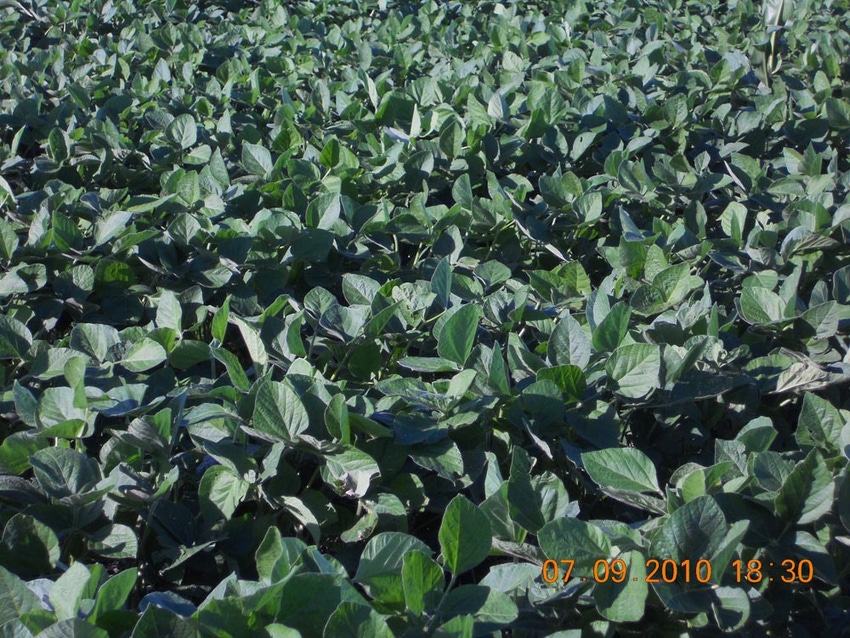
For Corn Belt farmers, rotational habits die hard. Many follow traditions laid out by generations before them, choosing to stay a proven course based on years of measurable success.
In the past 10 years, however, it’s likely that even the most systematic approaches to growing corn have been adapted, in part because of new technologies, but also because record grain prices allowed for a greater margin of experimental error.
The same can’t be said for the approach being taken by the same growers raising a soybean crop. In fact, one might surmise that corn yield progress has outpaced soybean progress so substantially the past 40 years, in part because growers have long viewed a soybean rotation only as a necessary evil to balance their corn rotation.
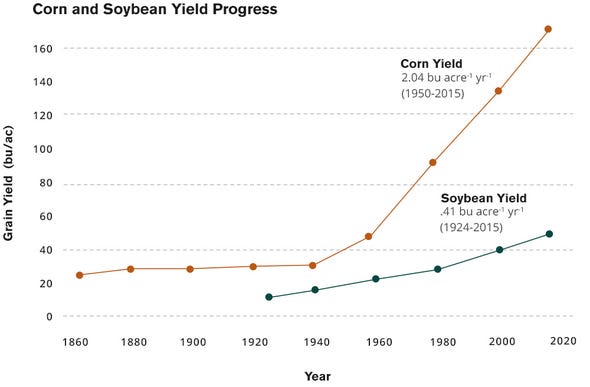
Before I joined the Mosaic Company, as a senior agronomist, I worked on research with Dr. Fred Below at the University of Illinois, that indicates growers might benefit from taking a page or two out of their corn-growing playbook and applying it to a more comprehensive approach to raising soybeans. The output of that research identified “Six Secrets of Soybean Success,” and underscores the opportunity for growers to make the most out of their soybean seed investment through a more thorough crop management approach.
Of course, there are prerequisites that are crucial before even entering this conversation: adequate soil drainage, season-long weed control and proper soil pH, to name three. Farmers with those baseline practices in check can closely evaluate the six secrets of soybean success and increase overall profit potential.
Six secrets of soybean success
Weather
Fertility
Genetics/Variety
Foliar Protection
Seed Treatment
Row Arrangement
Missing opportunity?
According to USDA research of growers in the top five soybean states, almost 80 percent apply neither phosphorus nor potassium to support the nutritional needs of their soybean crop. And it’s easy to understand why. Since the 1970s, very little research has actually been done regarding the importance of crop nutrition for soybeans — especially the importance of micronutrients on soybean.
As a part of my Ph.D. work at the University of Illinois, I addressed that void by studying how current soybean varieties, which produce far greater seed yield, are acquiring and using nutrients. What we found was that today’s soybean crops require a shocking amount of nutrients.
When examining the subject of soybean fertility, it’s best to start by studying how nutrients are used by the plant. The chart below shows key nutrients, how much of each is required for production, and how much of that nutrient is removed with the grain. The last column — Harvest Index — illustrates the percentage of total nutrient uptake that is in the grain. This factor is an indicator of how important nutrients are to produce grain.
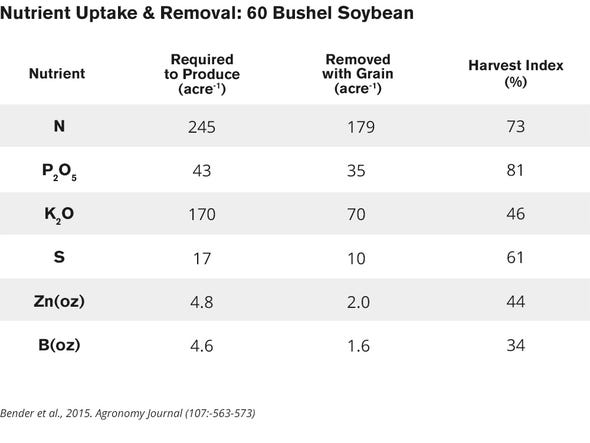
This information matters, because it tells us which nutrients are most important to raise a high-yielding crop. Nutrients that have high requirements for production — like nitrogen and potassium— are considered important. So, too, are nutrients that have high harvest index values.
After all, if we’re looking to increase yield, then doing a better job of providing then nutrients responsible for creating that yield should be a primary goal. This chart shows that nitrogen (N), phosphorus (P) and sulfur (S) should receive heightened attention for their performance in that regard.
Are we providing soybean crops enough of those nutrients to reach their potential? Let’s examine Phosphorus. One of three primary nutrients, phosphorus (P) is essential for plant growth, and a plant must access it to complete its normal production cycle. Plants absorb P from the soil as primary and secondary orthophosphates (H2PO4- and HPO42-).
According to USDA data, the average farmer applies about 90 pounds of P2O5 per acre prior to planting a corn crop. However, 80 percent of farmers don’t follow up with a subsequent phosphorus application prior to planting soybeans.
Let’s say you’re among that majority, and you raised a 230-bushel-per-acre corn crop, followed by a 60-bushel-per-acre soybean crop. You will have removed 115 pounds of P2O5 per acre at the end of the two-year rotation. Because the average farmer didn’t replenish with an application between harvests, in this hypothetical situation, you’ve depleted your soil by 25 pounds of P2O5 an acre after this two-year crop cycle.
So, you have to ask yourself: Was my soil able to supply enough, or did I run out of phosphorus? Did this nutrient limitation sacrifice yield, and could it have been prevented?
This graph illustrates the seasonal uptake of P for a 60-bushel soybean crop as well as where it’s allocated. Here’s the thing with phosphorus: It’s acquired rapidly and throughout much of the growing season. In fact, soybeans take up P rapidly for 70 days straight. If you’re like the 80 percent of producers who didn’t apply P before soybean, that means you hypothetically last applied phosphorus 18–20 months ago. Now it’s July or August, and your crop needs phosphorus badly. It’s anybody’s guess if it will find it.
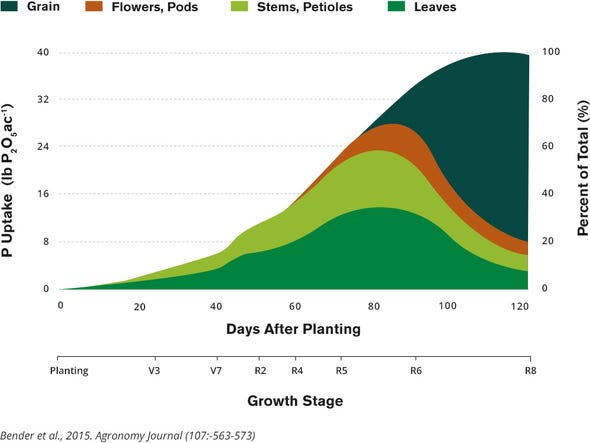
At the end of the season, the great majority of the phosphorus found in a soybean plant is in the grain, so when we harvest it, it’s removed forever. That’s why it’s so easy to deplete the soil to levels that can take years to rebuild.
The case for K
Potassium is also critically important for soybeans. For approximately 50 days, from the 40th through the 90th day after planting, approximately 3 pounds of K2O per acre per day is acquired, or almost 6 pounds of potash.
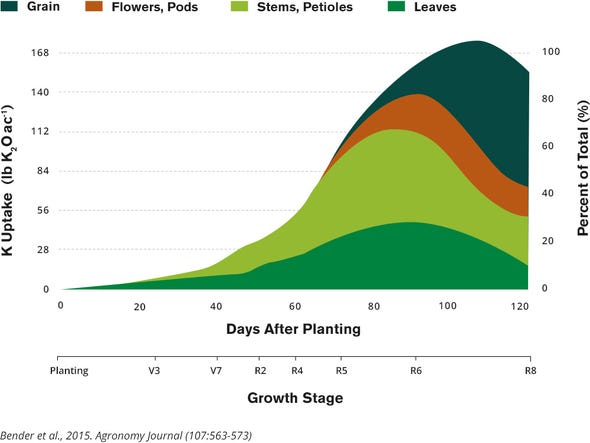
Sulfur for all season
Sulfur is another nutrient that requires discussion. But not just sulfur — season-long sulfur. Between its mobility in the soil and its propensity to become unavailable to the plant, S programs require some thought. The most effective sources typically provide early- and late-season availability. But, since there is a large need for sulfur in making the grain, it’s worth the extra attention.

Nutrition, A to Zinc
Zinc, a micronutrient particularly important during seed filling. If you want to produce high-yield soybean or corn, you need a lot of phosphate in the grain. Binding to that phosphate is zinc. That relationship means you can get more out of your phosphorus by making sure Zn is adequately available.
The official nutrient of pollination
If you’ve been hearing more about boron lately, you’re not at all alone. Growers are finding success with this micronutrient, and it’s easy to see why.
Boron is important all season long, but there is increased significance to its role during flowering. Boron is basically The Official Nutrient of Flowering, as it plays a critical role in that process.
Since it is needed throughout the season, but isn’t plant mobile, B needs to be accumulated through plant roots for the greatest impact. Although this isn’t the case for every nutrient, it is for boron, so ground applications typically work best.
What’s the bottom line?
Those who think soybeans are satisfied with scavenging the soil might be raising nutrient-starved soybeans.
Just think about what a soybean acre needs every day during peak growth:
4.1 pounds of N
0.7 pound of P2O5
3.4 pounds of K2O
0.3 pound of S
It’s clear. Improved soybean productivity requires a greater demand for plant-essential nutrients, but solving this puzzle is tricky. Gone is the “wait and hope” era of soybean fertility strategies. Today’s premium seed technologies require a forward-thinking approach, matched with premium fertilizer products. The Mosaic Company offers a suite of advanced crop nutrition products designed to meet your unique needs.
You May Also Like




